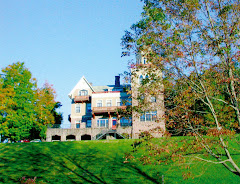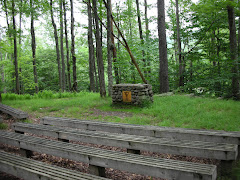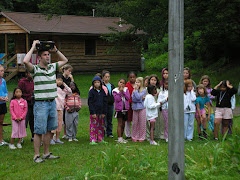 The late John Ketcham was inducted—tears flowing and hearts full of remembrance of this generous beautiful guy who died far, far too early—into the FV Hall of Fame on Saturday, along with his late father Frank. Earlier that morning, the Ketcham family, led by Jody Davies Ketcham, buried the ashes of John's and Jody's daughter Casey. I attended that service/meeting and then the burial, and I can hardly put words to how deep and moving it all was. We gathered in the Ketcham Chapel to remember Casey and then walked over onto Memorial Island to lay the ashes, sing a simple song, and then walk slowly over to the other side of the Biscuit Creek bridge where soon it was time to remember Casey's father John. Meantime, John's son Steve was on hand and his wife Ali and their new son John Lucas, whom we couldn't help but call John. And, oh my, does John look like Johnny Ketcham, his grandfather, when he was a baby. Readers of this blog can simply compare the new John Ketcham to the photo of Johnny with Frank and Mike at Wawayanda in 1948. Amazing likeness. Below you see a photo of John's dearest Wawayanda friend, Bev Gross Sutton, to whom little John took as if they were continuing the friendship Bev and John commenced in the very early days of Wawayanda at Frost Valley. Bev's letter to Casey, after her father's death, is quoted in the profile we wrote about John on the occasion of his induction. Steve gave the intruction speech, and Jody accepted the plaque on behalf of her late husband.
The late John Ketcham was inducted—tears flowing and hearts full of remembrance of this generous beautiful guy who died far, far too early—into the FV Hall of Fame on Saturday, along with his late father Frank. Earlier that morning, the Ketcham family, led by Jody Davies Ketcham, buried the ashes of John's and Jody's daughter Casey. I attended that service/meeting and then the burial, and I can hardly put words to how deep and moving it all was. We gathered in the Ketcham Chapel to remember Casey and then walked over onto Memorial Island to lay the ashes, sing a simple song, and then walk slowly over to the other side of the Biscuit Creek bridge where soon it was time to remember Casey's father John. Meantime, John's son Steve was on hand and his wife Ali and their new son John Lucas, whom we couldn't help but call John. And, oh my, does John look like Johnny Ketcham, his grandfather, when he was a baby. Readers of this blog can simply compare the new John Ketcham to the photo of Johnny with Frank and Mike at Wawayanda in 1948. Amazing likeness. Below you see a photo of John's dearest Wawayanda friend, Bev Gross Sutton, to whom little John took as if they were continuing the friendship Bev and John commenced in the very early days of Wawayanda at Frost Valley. Bev's letter to Casey, after her father's death, is quoted in the profile we wrote about John on the occasion of his induction. Steve gave the intruction speech, and Jody accepted the plaque on behalf of her late husband.Click here to see and read a copy of the profile as it appeared in the program.
Photo above: We gather at Memorial Island in Reflection Pond to bury Casey's ashes.
John Ketcham
Bev Gross (now Bev Gross Sutton, legendary Girls’ Camp
personage in her own right) met Johnny Ketcham at Wawayanda when they were
teenagers. They grew up there and worked as waterfront counselors together for
several summers, after which they remained close friends for a lifetime. Soon
after John’s death—cancer took him far, far too young—Bev decided to describe
her experiences with and feelings about John in a long letter to Casey, John
and Jody Davies Ketcham’s daughter. “What I remember most vividly about working
on the waterfront with your dad,” Bev told Casey,
was that Lake Cole in June felt
like swimming in glacial waters. It took your breath away; it paralyzed your
limbs. Every counselor struggled to seduce the children to swim, but every
camper balked at every suggestion....every camper except, of course, the
campers in Johnny's group. He and his kids would be in the water, splashing
happily and practicing their strokes. When his children emerged from their
lessons, their toes and fingers were purple, their teeth were chattering and
they were covered with goose bumps the size of jelly beans. Yet a radiant smile
always framed their blue lips. John knew how to inspire people to reach beyond
their grasp.
Everyone who encountered John Ketcham felt this particular
kind of inspiration—the kind that shows you how to live rather than tells you;
the kind that creates confidence with a smile and modest show of physical and
emotional strength; the kind that made everyone around him “reach beyond their
grasp.” Today we honor John Ketcham with induction into the Frost Valley Hall
of Fame—and with sorrow we must do it posthumously—in the realization that no
one who has graced this Valley ever better embodied the values of caring,
respect, and responsibility together in one soul. He was unfailingly kind to
everyone; he loved Wawayanda and Frost Valley and did everything he could,
always, to make it a better place for kids; he accepted far more than his share
of commitments and complex burdens and never diminished his capacity for love
in doing so.
 |
| Bev Gross Sutton holds John Ketcham's grandson. |
 |
| John's sister Billie Ketcham Heath says a few words. |
John’s death was a great blow to that hope. But, as Bev
wrote Casey, “Every one who knew Johnny, every one who ministered to him during
his illness, every one who attended his service, has been changed for the
better. We have each been summoned, in his name, to follow his example. I
hope you can find solace in knowing that you are the child of a truly great
man.” If there were just one reason for Frost Valley’s Hall of Fame, it would
surely be this: to remind ourselves of such powerful examples of our Frost
Valley predecessors; to accept their loss as a challenge to make something
better here for children and families; to take solace as friends and family and
colleagues of a truly great man; to dive into the frigid water in that same hopeful
spirit and “splash happily”—inspiring people always and forever to reach beyond
their grasp.












